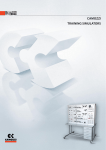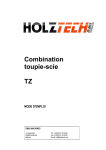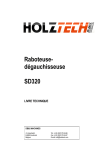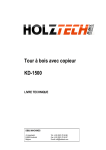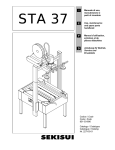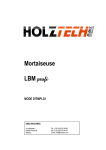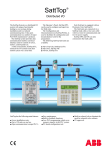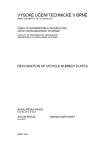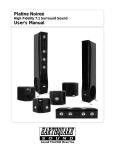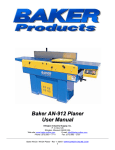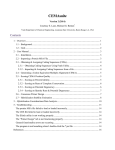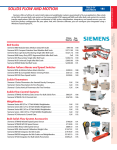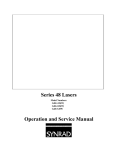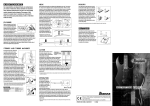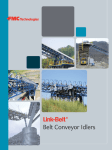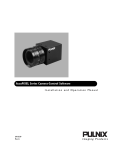Download manual
Transcript
Bandsaw LZ INSTRUCTION MANUAL DB&S MACHINES 4e Liniestraat 4 B-8650 Houthulst Belgium Tel.: (+32) (0)51/70.54.66 Fax: (+32) (0)51/70.54.67 E-mail: [email protected] HOLZTECH LZ CONTENTS 1. Guarantee 2. Technical data 3. Machine outfit 4. Optionals 5. EC Approval 5.1 Data plate 6. Noise level 7. Personal protection (EPI) 8. Intended use of the machine and contraindications 9. Overall dimensions 10. INSTALLATION 10.1 Positioning of machine and working environment 10.2 Lifting and positioning 10.3 Dust extraction system 10.4 Electric connection 10.5 Start up 10.6 2 speed motor 10.7 Electic diagram 11. USING THE MACHINE 11.1 Assembly and adjustment of the blade and its angle 11.2 Adjusting the blade fence 11.3 Table clamping 11.4 Dust extraction hood 11.5 Fence and parallelism 11.6 Table tilting 12. CHOICE OF BLADES AND MAINTENANCE 13. BRAKE 14. SAFETY DEVICES - ADVICE FOR USE - PRECAUTIONS 14.1 Stopping the machine 14.2 Advice - Precautions 14.3 Examples of safe working procedures 15. MAINTENANCE 15.1 Machine maintenance 15.2 Electromagnetic motor brake maintenance 16. TROUBLESHOOTING 17. ORDERING SPARE PARTS PARTS LIST WWW.HOLZTECH.COM 2 HOLZTECH LZ 1. GUARANTEE All our machines undergo strict controls before leaving our factory, and are in perfect working order when shipped. They are guaranteed against any manufacturing defects, provided they have been used and maintained properly. We accept no responsibility for malfunctions or faults in the electrical system. The machine is guaranteed for 6 months from the delivery date. If any malfunctions are encountered, the customer must proceed as follows: Report the problem or defect to DB&S. With authorization from DB&S, the customer may repair the machine in accordance with the specific instructions provided. If any work is done without DB&S's authorization, the guarantee will immediately become null and void. If DB&S decides to do repairs in person, the guarantee will become null and void if the engineer discovers that any devices of importance for proper operation of the machine have been tampered with. Replaced or faulty parts must be kept at the disposal of DB&S if the latter wishes to examine them. CAUTION: users are advised to read this user manual carefully and keep it for future consultation. DB&S declines all responsibility for the machine and its components if work has been done on them by unauthorized staff. The customer or dealer may never carry out any repairs or maintenance on the machine without the authorization of DB&S. THE CUSTOMER ... Mechanical installation by ... Electrical installation by ... Date: .... 3 WWW.HOLZTECH.COM HOLZTECH LZ 2. TECHNICAL DATA LZ 500 LZ 600 LZ 700 LZ 800 LZ 900 Flywheel diameter mm Table dimensions mm Cutting capacity mm Flywheel width mm Flywheel speed g/min Max/min blade length 6280/6200 Max/min blade width Max/min blade length 500 580x630 290x475 35 720 mm 600 580x800 345x585 35 715 3990/3910 700 694x1010 435x680 40 782 4460/4390 800 810x1145 410x780 40 704 5190/5060 900 810x1205 450x840 50 704 5490/5410 mm mm 30/10 Max/min blade width Blade thickness mm Motor power kw Overall dimensions 165x85X270 Net weight kg mm 0.6 1.5 cm 0.6 0.7 0.8 0.9 2.2 3 4 5.5 90x57x191 106x63x210 130x76x235 140x86x246 210 242 375 505 DS500 DS600 DS700 DS800 Flywheel diameter mm Table dimensions mm Cutting capacity mm Flywheel width mm Flywheel speed g/min Max/min blade length Max/min blade width Blade thickness mm Motor power kw Overall dimensions 500 580x630 300x484 35 720 mm mm 0.6 1.5 cm 600 700 800 580x800 694x1010 810x1145 360x580 440x680 410x790 35 40 40 715 782 704 3990/3900 4420/4325 5190/5040 30/10 30/10 40/15 40/15 0.6 0.7 0.8 2.2 3 4 90x57x191 106x63x210 130x76x235 Net weight 212 245 kg 30/10 40/15 75 384 3. MACHINE OUTFIT • User manual • Limit stop pusher 4. OPTIONALS • • • • • • • 2 speed motor Single-phase motor power up to kW 1,5 (x 500) - 2,2 (x 600) Fence for 45° tilted cuts. Blade Motor power 3kw (x 600) Motor power 4kw (x 700) Motor power 5.5kw (x 800) For the SR/900: • Flywheel width 75 mm • Scraperblades • Motor power 10 HP or 20 HP WWW.HOLZTECH.COM 40/1550/30 6240/6180 4 540 724 5480/5425 140x86x246 HOLZTECH LZ • Upper and lower blade fence of the CHACO type. • Height cutting capacity 550 mm The options are supplied for manual handling of workpieces only. no feed device can in any manner be fitted to this type of machine. 5. EC APPROVAL EC approval has been granted for the models LZ 500/600 - DS 500/600 by the French Testing Institute INRS, Approval N. 0070 040A 5023 02 95 EC approval for models SR 700/800/900 - DS 700/800 has been granted by INRS with Approval N. 0070 040A 5025 02 95 5.1 Machine data plate The machine is equipped with a data plate attached to the side of the machine bed, in which the identification data of each bandsaw model are indicated. - EC mark - Manufacturer’s address - Model - Name of machine - Power - Voltage - Fabrication year - Amperage - Frequency 5 WWW.HOLZTECH.COM HOLZTECH LZ 6. NOISE LEVEL BANDSAWS SR 500 MEASUREMENT OF NOISE EMISSION ACCORDING TO ISO/DIS 7960 STANDARDS USE: Cutting of strips OPERATING CONDITIONS ACCORDING TO NF E 64-209 STANDARDS ----------------------------------------------------------------------------------------------Operator’s place Equivalent level Max. level Laeq dB(A) Lpeak dB ----------------------------------------------------------------------------------------------At workpiece inlet 80.5 > 135 At workpiece outlet (optional) -------------------------------------------------------------Acoustic power... only if Laeq>85 dB(A) BANDSAW SR 600 MEASUREMENT OF NOISE EMISSION ACCORDING TO ISO/DIS 7960 STANDARDS USE: Cutting of strips OPERATING CONDITIONS ACCORDING TO NF E 64-209 STANDARDS -----------------------------------------------------------------------------------------------Operator’s place Equivalent level Max. level Laeq dB(A) Lpeak dB -----------------------------------------------------------------------------------------------At workpiece inlet 79.8 > 135 At workpiece outlet (optional) --------------------------------------------------------------Acoustic power... only if Laeq>85 dB(A) BANDSAW SR 700 MEASUREMENT OF NOISE EMISSION ACCORDING TO ISO/DIS 7960 STANDARDS USE: Cutting of strips OPERATING CONDITIONS ACCORDING TO NF E 64-209 STANDARDS -----------------------------------------------------------------------------------------------Operator’s place Equivalent level Max. level Laeq dB(A) Lpeak dB -----------------------------------------------------------------------------------------------At workpiece inlet 82 > 135 At workpiece outlet (optional) ---------------------------------------------------------------Acoustic power... WWW.HOLZTECH.COM 6 HOLZTECH LZ only if Laeq>85 dB(A) BANDSAW SR 800 MEASUREMENT OF NOISE EMISSION ACCORDING TO ISO/DIS 7960 STANDARDS USE: Cutting of strips OPERATING CONDITIONS ACCORDING TO NF E 64-209 STANDARDS --------------------------------------------------------------------------------------------------Operator’s place Equivalent level Max. level Laeq dB(A) Lpeak dB --------------------------------------------------------------------------------------------------At workpiece inlet 83.5 > 135 At workpiece outlet (optional) ----------------------------------------------------------------------------Acoustic power... only if Laeq>85 dB(A) BANDSAW SR 900 MEASUREMENT OF NOISE EMISSION ACCORDING TO ISO/DIS 7960 STANDARDS USE: Cutting of strips OPERATING CONDITIONS ACCORDING TO NF E 64-209 STANDARDS --------------------------------------------------------------------------------------------------Operator’s place Equivalent level Max. level Laeq dB(A) Lpeak dB --------------------------------------------------------------------------------------------------At workpiece inlet 83.5 > 135 At workpiece outlet (optional) ----------------------------------------------------------------------------Acoustic power... only if Laeq>85 dB(A) 97.3 dBw(A) BANDSAW DS 500 MEASUREMENT OF NOISE EMISSION ACCORDING TO ISO/DIS 7960 STANDARDS USE: Cutting of strips OPERATING CONDITIONS ACCORDING TO NF E 64-209 STANDARDS -----------------------------------------------------------------------------------------------Operator’s place Equivalent level Max. level Laeq dB(A) Lpeak dB -----------------------------------------------------------------------------------------------At workpiece inlet 83.8 > 135 At workpiece outlet (optional) 7 WWW.HOLZTECH.COM HOLZTECH LZ ---------------------------------------------------------------------------Acoustic power... only if Laeq>85 dB(A) BANDSAW DS 600 MEASUREMENT OF NOISE EMISSION ACCORDING TO ISO/DIS 7960 STANDARDS USE: Cutting of strips OPERATING CONDITIONS ACCORDING TO NF E 64-209 STANDARDS -----------------------------------------------------------------------------------------------Operator’s place Equivalent level Max. level Laeq dB(A) Lpeak dB -----------------------------------------------------------------------------------------------At workpiece inlet 84 > 135 At workpiece outlet (optional) --------------------------------------------------------------------------Acoustic power... only if Laeq>85 dB(A) BANDSAW DS 700 MEASUREMENT OF NOISE EMISSION ACCORDING TO ISO/DIS 7960 STANDARDS USE: Cutting of strips OPERATING CONDITIONS ACCORDING TO NF E 64-209 STANDARDS -----------------------------------------------------------------------------------------------Operator’s place Equivalent level Max. level Laeq dB(A) Lpeak dB -----------------------------------------------------------------------------------------------At workpiece inlet 85 > 135 At workpiece outlet (optional) ---------------------------------------------------------------------------Acoustic power... only if Laeq>85 dB(A) BANDSAW DS 800 MEASUREMENT OF NOISE EMISSION ACCORDING TO ISO/DIS 7960 STANDARDS USE: Cutting of strips OPERATING CONDITIONS ACCORDING TO NF E 64-209 STANDARDS -----------------------------------------------------------------------------------------------Operator’s place Equivalent level Max. level Laeq dB(A) Lpeak dB -----------------------------------------------------------------------------------------------At workpiece inlet 85.2 > 135 At workpiece outlet (optional) ----------------------------------------------------------------------------Acoustic power... only if Laeq>85 dB(A) WWW.HOLZTECH.COM 8 HOLZTECH LZ Although there is a correlation between the emission level and the exposure level, this cannot be used directly to determine whether further precautions may be required. The factors influencing the actual noice level to which the personnel is exposed are the duration of the exposure, the workshop features, other noise sources, etc., i.e. the number of machines and other adjacent operations. Moreover, the permissible exposure level can vary from one country to another. However, the above information may help the user of the machine to a better evaluation of any risks. 7. PERSONAL PROTECTION - Gloves for handling material and for replacing the blade - Non-slip footwear - Protective goggles - Soundproofing ear-muffs or helmet 8. INTENDEDUSE OF THE MACHINE AND CONTRAINDICATIONS The machine may be used for cutting solid wood and similar materials (cork, bone, rubber, hard plastics and other similar hard materials) using blades having characteristics suitable for the function required: consult your blade supplier or manufacturer. Cutting with fence, finishing cuts on profiles and shaping cuts are possible. The machine is not able to cut metals or iron. The machine must be used within the limits imposed by the technical data, in accordance with the safety, use and maintenance instructions in this manual. The staff who use the machine must have served a suitable period of apprenticeship in its use and maintenance and must have the minimum age required by the legislation in the various countries. Personal protection (EPI art. 7) must be used and the specific precautions mentioned in the manual must be taken, also using any equipment appropriate to the specific working conditions. Always use the machine with the dust extraction system operating, even when cutting single pieces. All safety measures have been applied in relation to the instructions given above; use of the machine for different functions and/or modifications without the constructor's prior consent are forbidden. CAUTION! FURTHER RISKS (§ 172 of directive) We call the attention of the manufacturing managers and the operators on the further risks involved with bandsaws. In fact, access to the sawblade is always possible, even if the guards are correctly adjusted at the workpiece passage height. Therefore: Use a pusher when handling pieces near the cutting edge (see § 14-3 below, page 24). - Keep your hands far from the rotating sawblade between two workpiece strokes. - Lower the guard to touch the worktable when the machine is to be left unused for a long time. 9 WWW.HOLZTECH.COM HOLZTECH LZ 9. OVERALL DIMENSIONS 500 600 700 800 900 A B C D E 1860 2060 2320 2400 2700 900 1060 1300 1400 1650 855 875 920 100 100 100 970 635 635 760 100 140 1020 MODEL SR MODEL DS WWW.HOLZTECH.COM 10 855 980 HOLZTECH LZ 10. INSTALLATION 10.1 Positioning of machine and working environment 11 WWW.HOLZTECH.COM HOLZTECH LZ WWW.HOLZTECH.COM 12 HOLZTECH LZ Key to symbols 500 600 700 800 900 Lmax = maximum length 6040 6040 6170 6260 6390 Lw = length required for machining and maintenance 2000 2000 2000 2000 2000 Ln = machine length 640 640 770 860 990 La = widyh required auxiliar 700 700 700 700 700 Wmax = maximum width 4400 4560 4800 4900 5150 Ww = machine width 900 1060 1300 1400 1650 Wn = width required for machining and maintenance1500 1500 1500 1500 1500 13 WWW.HOLZTECH.COM HOLZTECH LZ Wa = width required for workpiece passage 1000 WWW.HOLZTECH.COM 1000 1000 1000 1000 14 HOLZTECH LZ 10.2 Lifting and positioning (Fig. 1) The machine can be lifted with the help of stell cables as indicated in Fig. 1 or using a fork lift truck by introducing the forks under the macine bed. When a fork lift is used to move the machine, antislip material will have to be placed between the metal bed and the truck forks to prevent accidental falls or slipping. We recommend taking the utmost caution when handling the machine, especially during loading, unloading and positionning on the chosen work site. Only competent persons should use the special handling devices to avoid the presence of other people in the immediate vicinity of the machine being handled. FIG. 1a To create a confortable and rational work station, follow these instructions: a) install the machine where there are no vibrations or noise b) ensure adeguate lighting c) if the machine is installed near other machines, the distance on either side between the bandsaw and the other machines must be at least 80 cm. Ensure sufficient room for cutting long planks and the fitting of supports at machine infeed and outfeed. d) the base should not be rigidly fixed to the floor, since a great base deformation during tightening could cause deformation and as a consequence machine vibrations. e) level the machine with a spanner (1-fig.1a) by adjusting the screws at the four corners of the feet until the unit is stable and does not vibrate. 15 FIG. 1 WWW.HOLZTECH.COM HOLZTECH LZ 10.3 Dust extraction system Connect the machine to an effecting dust extraction system with a connection having inside diameter 100 mm (Fig. 2). At a speed of 20 m/sec., the air flow-rate for each connection is 200 m3/h. If the wood is damp, the air speed may be increased up to 28 m/sec., giving a flow-rate of 1600 m3/h. for each dust extraction outlet. The extraction pipe diameter for bandsaw SR/900 is 140 mm. Considering an air speed of 20 m/sec., the flowrate for each outlet will be 1600 m3/h. SR-DS 500/800 D= 100mm SR 900 D= 140mm FIG. 3 10.4 Electric connection First of all make sure the machine voltage corresponds to that of mains. If voltage is 380 V, the minimum cross-section of the power supply cables must be at least 2.5 mm2, including the earth wire. For 220 V voltage and/or motor increase (absorption > 18 A) installed on request, the cross-section must be increased accordingly. The electric connection must be made in the terminal box (fig.3) by a skilled electrician. Connect the power wires to the terminals R-S-T (13-5) and the earth wire to the terminal with the earth symbol (Fig. 3a). On start-up, check the rotation direction on threephase machines; if the flywheel turns the wrong way, stop immediately and exchange the connections of the phase wires. The general switch can be locked to prevent the machine being used by unauthorized person (fig.4). WWW.HOLZTECH.COM 16 FIG. 3a FIG. 4 HOLZTECH LZ 10.5 Start-up To start models 500 and 600, repeat the following operations (Fig. 5). - place the master switch located on the back of the machine to 1(Fig. 4), which makes telltale H1 turn on. - press button 1 of the overload cutout QF1. To lock the machine, press overload cutout QF1. the upper button 0 of the If the power supply fails for any reason, including operation of a safety switch, press button 1 of the overload cutout QF1 to restart the bandsaw. The braking switch S1 is equipped with a built-in yellow led H2. FIG. 5 For star-delta starting of models 700/800/900, carry out the following operations (Fig. 6): - place the master switch located on the back of the machine to 1(Fig. 4), which makes telltale H1 turn on. - press button 1 of overload cutout QF1 - start the machine with star-delta switch SB1 to 1 in two different phases to enable the motor gradually to reach peak rpm. When there is no voltage, the star-delta switch must be set to 0 and press overload cutout button 1. The brake release device is built into the star-delta switch(position F). FIG. 6 17 WWW.HOLZTECH.COM HOLZTECH LZ To stop the machine, operate the emergency switch located under the right corner of the work table or set the star-delta switch to 0. The control circuit fuses are situated inside the eletric cabinet. WWW.HOLZTECH.COM 18 HOLZTECH LZ 10.6 2-speed motor (optional) On request the machines can be equipped with 2-speed motors for cutting plastic and light alloy materials. The motors to be installed on the various types of bandsaws are the following: MODEL MOTOR 500 2 HP 3 HP RPM 2800 1400 FLYWHEEL ROTATION SPEED 720 360 600 2 HP 3 HP 2800 1400 715 358 700 3 HP 4 HP 2800 1400 780 390 800 4 HP 5.5 HP 2800 1400 704 352 In this case the machines are equipped with a 2-speed switch (fig. 7) with auxiliary contacts for three-phase version. For the single-phase version there will be a two-speed switch with an auxiliary position marked AVV. To start the machine turn the lever toward the position 1 or 2, and subsequently move it into position AVV. With Models 500 and 600 it will therefore be possible to cut plastic and light alloy materials at a lower speed with a cross-section ranging from min. 10 to 15 cm and from min. 15 to 20 cm for Models 700 and 800. FIG. 7 FIG. 7a 10.7 Wiring diagram In the following pages we will list the electric diagram of one speed and two speed machines. 19 WWW.HOLZTECH.COM HOLZTECH LZ NOMENCLATURE OF EQUIPMENT OF ELECTRIC DIAGRAM OF SR-DS 500/600 DIRECT SINGLE-PHASE POS. DESCRIPTION MANUFACTURE ARTICLE Q1 QF1 GENERAL SWITCH MOTOR OVERLOAD CUTOUT 70402 MBS25 KA MINIMUM VOLTAGE COIL FU1 CONTROL PROTECTION FUSE HL2 VOLTAGE ON TELLTALE - white HL1 MANUAL BRAKE TELLTALE - yellow GEWISS AEG TELEMECANIQUE KLOCHNER HS9.11 TELEMECANIQUE HAGER WEBER BREMAS CEMA KLOCHNER BREMAS CEMA KLOCHNER SA2 MANUAL BRAKE SWITCH YB1 MC1 ELECTRIC BRAKE 220V SAFETY LIMIT-SWITCH MC2 SAFETY LIMIT-SWITCH M1 2-SPEED MOTOR - 220 V PE EARTH CLAMP AEG L501 AEG TELEMECANIQUE PIZZATO TELEMECANIQUE PIZZATO TELEMECANIQUE CEG SEIMEC ELECTRIC DIAGRAM OF SR-DS 500/600 DIRECT SINGLE-PHASE WWW.HOLZTECH.COM 20 FR 515 FR 515 HOLZTECH LZ 21 WWW.HOLZTECH.COM HOLZTECH LZ NOMENCLATURE OF EQUIPMENT OF ELECTRIC DIAGRAM OF SR-DS 500/600 DIRECT THREE-PHASE POS. DESCRIPTION MANUFACTURE ARTICLE Q1 QF1 GENERAL SWITCH MOTOR OVERLOAD CUTOUT GEWISS AEG TELEMECANIQUE KLOCHNER 70402 MBS25 T1 KA TRASFORMER 0-380/0-220 MINIMUM VOLTAGE COIL AEG FU1/2 CONTROL PROTECTION FUSE HL2 VOLTAGE ON TELLTALE - white HL1 MANUAL BRAKE TELLTALE - yellow SA1 MANUAL BRAKE SWITCH YB1 SQ1 ELECTRIC BRAKE 220V SAFETY LIMIT-SWITCH SQ2 SAFETY LIMIT-SWITCH M1 MOTOR PE EARTH CLAMP HS9.11 TELEMECANIQUE HAGER WEBER BREMAS CEMA KLOCHNER BREMAS CEMA KLOCHNER L501 AEG TELEMECANIQUE PIZZATO TELEMECANIQUE PIZZATO TELEMECANIQUE CEG SEIMEC ELECTRIC DIAGRAM OF SR-DS 500/600 DIRECT THREE-PHASE WWW.HOLZTECH.COM 22 FR 515 FR 515 HOLZTECH LZ NOMENCLATURE OF EQUIPMENT OF ELECTRIC DIAGRAM OF SR-DS 600 DIRECT THREE-PHASE(WITH POWER 3KW) POS. DESCRIPTION MANUFACTURE ARTICLE Q1 QF1 GENERAL SWITCH MOTOR OVERLOAD CUTOUT GEWISS AEG TELEMECANIQUE KLOCHNER 70402 MBS25 T1 KA TRASFORMER 0-380/0-220 MINIMUM VOLTAGE COIL AEG FU1/2 CONTROL PROTECTION FUSE HS9.11 TELEMECANIQUE HAGER 23 L501 WWW.HOLZTECH.COM HOLZTECH LZ HL2 VOLTAGE ON TELLTALE - white HL1 MANUAL BRAKE TELLTALE - yellow SA1 MANUAL BRAKE SWITCH WEBER BREMAS CEMA KLOCHNER BREMAS CEMA KLOCHNER AEG TELEMECANIQUE YB1 SQ1 ELECTRIC BRAKE 220V SAFETY LIMIT-SWITCH SQ2 SAFETY LIMIT-SWITCH M1 MOTOR PE EARTH CLAMP SA2 EMERGENCY PUSH-BUTTON PIZZATO TELEMECANIQUE PIZZATO TELEMECANIQUE CEG SEIMEC BREMAS TELEMECANIQUE ELECTRIC DIAGRAM OF SR-DS 600 DIRECT THREE-PHASE ( WITH POWER 3KW) WWW.HOLZTECH.COM 24 FR 515 FR 515 HOLZTECH LZ NOMENCLATURE OF EQUIPMENT OF ELECTRIC DIAGRAM OF SR-DS 700/800 START-DELTA THREE-PHASE POS. DESCRIPTION MANUFACTURE ARTICLE Q1 MT GENERAL SWITCH MOTOR OVERLOAD CUTOUT GEWISS AEG TELEMECANIQUE KLOCHNER 70402 MBS25 T1 KA TRASFORMER 0-380/0-220 MINIMUM VOLTAGE COIL AEG FU1/2 CONTROL PROTECTION FUSE HL2 VOLTAGE ON TELLTALE - white HL1 MANUAL BRAKE TELLTALE - yellow YB1 FC1 ELECTRIC BRAKE 220V SAFETY LIMIT-SWITCH FC2 SAFETY LIMIT-SWITCH M1 MOTOR PE SB1 SA1 EARTH CLAMP START-DELTA SWITCH EMERGENCY PUSH-BUTTON HS9.11 TELEMECANIQUE HAGER WEBER BREMAS CEMA KLOCHNER BREMAS CEMA KLOCHNER PIZZATO TELEMECANIQUE PIZZATO TELEMECANIQUE CEG SEIMEC L501 FR 515 FR 515 BREMAS AEG 25 WWW.HOLZTECH.COM HOLZTECH LZ ELECTRIC DIAGRAM OF SR-DS 700/800 STAR-DELTA THREE-PHASE WWW.HOLZTECH.COM 26 HOLZTECH LZ NOMENCLATURE OF EQUIPMENT OF ELECTRIC DIAGRAM OF SR-DS 500/600 2 SPEED-MOTOR THREE-PHASE POS. DESCRIPTION MANUFACTURE ARTICLE Q1 QF1 GENERAL SWITCH MOTOR OVERLOAD CUTOUT GEWISS AEG TELEMECANIQUE KLOCHNER 70402 MBS25 T1 KA TRASFORMER 0-380/0-220 MINIMUM VOLTAGE COIL AEG FU1/2 CONTROL PROTECTION FUSE HL2 VOLTAGE ON TELLTALE - white HL1 MANUAL BRAKE TELLTALE - yellow YB1 SQ1 ELECTRIC BRAKE 220V SAFETY LIMIT-SWITCH SQ2 SAFETY LIMIT-SWITCH M1 MOTOR PE SB1 SA2 EARTH CLAMP POLARY SWITCH MANUAL BRAKE SWITCH HS9.11 TELEMECANIQUE HAGER WEBER BREMAS CEMA KLOCHNER BREMAS CEMA KLOCHNER PIZZATO TELEMECANIQUE PIZZATO TELEMECANIQUE CEG SEIMEC L501 FR 515 FR 515 BREMAS AEG 27 WWW.HOLZTECH.COM HOLZTECH LZ ELECTRIC DIAGRAM OF SR-DS 500/600 2-SPEED THREE-PHASE WWW.HOLZTECH.COM 28 HOLZTECH LZ NOMENCLATURE OF EQUIPMENT OF ELECTRIC DIAGRAM OF SR-DS 500/600 2 SPEED-MOTOR SINGLE-PHASE POS. DESCRIPTION MANUFACTURE ARTICLE Q1 QF1 GENERAL SWITCH MOTOR OVERLOAD CUTOUT 70402 MBS25 KA MINIMUM VOLTAGE COIL FU1 CONTROL PROTECTION FUSE HL2 VOLTAGE ON TELLTALE - white HL1 MANUAL BRAKE TELLTALE - yellow GEWISS AEG TELEMECANIQUE KLOCHNER HS9.11 TELEMECANIQUE HAGER WEBER BREMAS CEMA KLOCHNER BREMAS CEMA KLOCHNER YB1 MC1 ELECTRIC BRAKE 220V SAFETY LIMIT-SWITCH FR 515 MC2 SAFETY LIMIT-SWITCH M1 2 SPEED-MOTOR PIZZATO TELEMECANIQUE PIZZATO TELEMECANIQUE CEG SEIMEC PE SB1 SA2 EARTH CLAMP POLARY SWITCH MANUAL BRAKE SWITCH AEG L501 FR 515 BREMAS AEG ELECTRIC DIAGRAM OF SR-DS 500/600 2-SPEED SINGLE-PHASE 29 WWW.HOLZTECH.COM HOLZTECH LZ NOMENCLATURE OF EQUIPMENT OF ELECTRIC DIAGRAM OF SR-DS 700/800 2SPEED THREE-PHASE POS. DESCRIPTION MANUFACTURE ARTICLE Q1 QF1 GENERAL SWITCH MOTOR OVERLOAD CUTOUT GEWISS AEG TELEMECANIQUE KLOCHNER 70402 MBS25 T1 KA TRASFORMER 0-380/0-220 MINIMUM VOLTAGE COIL AEG FU1/2 CONTROL PROTECTION FUSE WWW.HOLZTECH.COM HS9.11 TELEMECANIQUE HAGER WEBER 30 L501 HOLZTECH LZ HL2 VOLTAGE ON TELLTALE - white HL1 MANUAL BRAKE TELLTALE - yellow YB1 SQ1 ELECTRIC BRAKE 220V SAFETY LIMIT-SWITCH SQ2 SAFETY LIMIT-SWITCH M1 2 SPEED-MOTOR PE SB1 SA2 SA1 EARTH CLAMP POLARITY SWITCH MANUAL BRAKE SWITCH EMERGENCY PUSH-BUTTON BREMAS CEMA KLOCHNER BREMAS CEMA KLOCHNER PIZZATO TELEMECANIQUE PIZZATO TELEMECANIQUE CEG SEIMEC FR 515 FR 515 BREMAS AEG AEG 31 WWW.HOLZTECH.COM HOLZTECH LZ ELECTRIC DIAGRAM OF SR-DS 700/800 2-SPEED THREE-PHASE 11. USING THE MACHINE SR - DS The instructions regarding saefty on work are indicated in item 14 - pag. 33 Item Description Q Type 1 2 3 4 5 6 7 8 9 10 11 12 13 14* Top cover Blade guard Dust extraction system line Lower cover Motor brake release Switch contactor Warning light Blade fence fastener Up/down command Blade tension adjustment Motor brake Worktable Flywheel adjuster knob Star-delta switch 1 1 1 1 1 1 steel steel nylon steel Bremas A.E.G. Bremas thermoset material thermoset material thermoset material 1 1 thermoset material Bremas WWW.HOLZTECH.COM 1 1 1 1 1 32 HOLZTECH LZ 15 16 * Fence clamp handwheel General knife switch Only for models 700/800/900 1 1 thermoset material Brema 33 WWW.HOLZTECH.COM HOLZTECH LZ 11.1 Assembly and adjustment of the blade and its angle Before fitting the blade, first release the automatic brake. When the machine is not working, to release the brake on models 500 and 600 it is necessary to turn the S1 selector (fig. 5, page 14) lighting the incorporated indicator, H1. For models 700,800,900 use the start - tringle, pushing it down and turning it into position F (fig. 6, page 14). Put the switch back into normal position before starting the machine. Then return the switch to the normal position to allow the machine to be restarted. None of the safety devices must be removed during this procedure. To fit the blade, open the doors 1 and 2 (Fig. 8) lower the guard 3 to table level and turn it clockwise. Fit the blade and bring it to a moderate tension using handwheel 5 (pictografy -fig.8) according to the indication is the figure 9 and to the width of the blade. Turn the flywheels by hand to check: a) that there is no friction between the blade and the fixed parts of the machine, b) that the blade is installed correctly on the flywheel seal (Fig. 10). Reposition guard 3 and close doors 1 and 2. Angle adjustment For long life of the blade and the flywheel tyres, the teeth must project beyond the edges of the flywheels. The machine is tested before delivery, and is thus supplied with the flywheels correctly positioned.To adjust the angle of the flywheel, back off the clamp 1 (Fig. 10), and turn the handwheel 2 in direction A to increase the projection of the teeth, or in direction B to reduce. FIG.8 If blades of width less than 20 mm (∅ 500/600), 25 mm (∅ 700/800) or 30 mm (∅ 900) are used, they cannot be adjusted with protruding teeth, so they will remain the middle (contouring, bent cutting, etc.). Then lock the brake. To adjust the blade fence wheels see par. 11.2. Two microswitches prevent the machine from starting up if the flywheel covers are open. After use, slacken the blade completely to prevent the flywheel seals from deforming and causing vibration.When the blade is not taut, place a warning sign on the machine. FIG.10 WWW.HOLZTECH.COM 34 HOLZTECH LZ 11.2 Blade guide adjustment Upper blade guide The blade guide, rigidly mounted on the guard, must be adjusted to a height of 4-5 mm above the board to be cut. To adjust its height, back off the clamp 1 (Fig. 11), turn the handwheel 2 by hand (pictografy-fig.11) and lock it in the position required. The rear roller 1 (Fig. 12) must be positioned about 2 mm from the back of the blade to prevent it returning excessively during cutting; the position can be adjusted using the screw 2 (Fig. 12). During the idle return stroke, the back of the blade must not be permanently in contact with the roller. When using blades up to a specific length (see par. 11.1) the side rollers 3 (Fig. 12) must just touch the sides of the blade, allowing the teeth to project, to prevent the blade from bending to the side and reduce any vibrations during cutting. They can be adjusted using the screws 4 (Fig. 12) with clamping in position by means of the screws 5 (Fig. 12). When using very narrow blades the rollers 3 FIG. 11 (fig. 12) cannot touch the blade, so they must be opened further so as to prevent them from touching the teeth. The blade fence does not require greasing. Lower blade guide The machine is equipped with a lower blade guide of the roller type (Fig. 13), the adjustment is the same as for the upper blade guide. Adjustment of blade guide CHACO (option SR900 with blade 75mm) Adjustment of blade guide CHACO (fig. 14) with inserts in graphite material. FIG. 13 35 FIG. 12 WWW.HOLZTECH.COM HOLZTECH LZ In this case also the blade guide integral with the guard must be adjusted in height at 4-5 mm from the workpiece. For this adjustment, see item 11.2 and follow the instructions for the adjustment of the roller guide and follow the indications for the adjustment of the roller guide(fig. 11 and fig.11A). The adjustment of the graphite inserts (fig.14) must be carried out with a pusher. There must not be any permanent contact between the back of the entire blade and the inserts during the idle return stroke. The inserts are worn over time and must be regularly replaced. 11.3 Table block On models 500/600/700 the table block A (fig. 15) is made of nylon and equipped with 4 screws C (fig. 14) to allow for alignment of the block in relation to the worktable. This adjustment has been carried out during the testing of the machine, and it should not be necessary to regulate it except if it must be replaced. Models 800 and 900 are equipped with a wooden block with the dimensions indicated in fig. 16. 11.4 Chute The chute is provvided , but the cut for the passage of the blade must be made by the user. Our machines have undergone dust emission tests; to keep them in good condition, replace the sawdust remover chute when the slot for passage of the blade becomes wider and good removal is no longer ensured. 11.5 Guide and parallel settings FIG. 15 If cutting is not perfectly parallel during operation with the guide, the main causes may be: a) blade too slack b) incorrect sharpening or setting c) guide not parallel to blade To correct the guide position, unscrew the two fastening screws (Fig. 17), adjust the position of the bar as indicated, and then secure in position. FIG.16 WWW.HOLZTECH.COM FIG. 17 36 HOLZTECH LZ 11.6 Table tilt The table tilts by up to 20°. To tilt the table, extract the table block in nylon or in wood to allow for the passage of the blade through the opening, unscrew the table fastening screw (fig. 18) tilt the table to the value indicated in the table and lock it in that position. FIG.18 11.7 Regolation fence for tilted (optional) For adjustment, back off bolt A (fig.19) and place the fence as according to the type of cut to be carried out. The operator can choose the cutting angle according to requirements. The fence for tilted cuts slides in the table groove and is used for cutting-off operations. Blade FIG. 19 12. CHOICE OF BLADES AND MAINTENANCE The dimensions of the blade (length, width and thickness) must be within the minimum and maximum limit values indicated in the technical data (section 3). Blades are defined by the their width, their conformation and the number of teeth they have. Narrow blades are suitable for curved or profile cuts, and wide blades for straight cuts. The conformation and the number of teeth depend on the thickness and the material to be cut: the thicker the material, the smaller the number of teeth, for better shaving removal and to prevent the blade from jamming or overheating. Blade setting will be greater (twice the thickness of the blade) for soft and fibrous materials, and less (1.5 - 1.3 times the thickness of the blade) for hard materials. When the blade is not sufficiently sharp, replace it immediately. In case of breakage, the teeth must be set and the blade sharpened and welded by skilled staff using suitable equipment. Poor welding may cause vibrations on the machine. The main causes of breakage are: a) imperfect welding, b) excessive thickness in relation to the flywheel diameter, 37 WWW.HOLZTECH.COM HOLZTECH LZ c) blade too taut: the spring is too compressed and is therefore not performing its function, d) outside surface of flywheels dirty, e) the blade is not sharp enough and/or tooth setting is uneven, f) the blade fence position is incorrect (too much friction on the blade), g) the flywheel angle is not correct for the blade position, h) the four rear screws locking the lower flywheel shaft are tightened too much and the flywheel axis is displaced. WWW.HOLZTECH.COM 38 HOLZTECH LZ 13. BRAKE An electropneumatic mechanical brake assures that the moving parts stop within a time of less than 10 seconds. The brake is subject to wear, and so it must be checked regularly, and adjusted or replaced when necessary to assure that the machine stops within the time limits envisaged. For adjustments and replacement, read the instructions in item 15.2 carefully. 14. SAFETY DEVICES - ADVICE FOR USE - PRECAUTIONS 14.1 Stopping the machine For any work on the machine (maintenance, repairs or modifications), stop the machine and carry out the following three operations: - disconnect the machine from the electrical mains; - padlock the circuit breaker; - check that the machine is not receiving power and that there is no residual, potential or kinetic energy (springs). Only one person must be responsible for carrying out these three operations. In case of simple procedures, this person may be the operator himself. Locking of the machine is carried out by padlocking the master switch. If the machine is out of order for any reason, stop the machine as described above and place a warning sign on it. 14.2 Advice - Precautions Before operation - There must be nothing on the floor around the machine, to avoid unsteadiness on the feet, - Wear suitable working clothes which are not loose fitting, - check that the blade is well sharpened, taut and well positioned on the flywheels, - adjust the height of the upper blade fence so that it is 4-5 mm above the board to be processed, and check that the other protective devices are in position and properly adjusted, - position any supports or rests for long or large boards. - turn on the general dust extraction system During operation - Never clean the table with your hands: use a brush, with the blade at a standstill, - use the pusher when cutting short, narrow or thin pieces, - if the blade breaks, stop the machine and wait for the flywheels to come to a complete stop before doing anything else, - when work is over, slacken off the blade and place a warning sign on the machine to indicate this. During maintenance -Disconnect the machine as described above -use tough gloves when handling the blades -check the earth connection periodically. 39 WWW.HOLZTECH.COM HOLZTECH LZ 14.3 Examples of safe working procedures N.B : for cutting of very small pieces it is necessary to use the pusher delivered with the machine. ATTENTION! The sawblade fence base must in any case be positioned FIG.20 as near as possible to the workpiece. Max. clearance 5 mm. Longitudinal cuts along profiles (Fig. 20) Push the wood evenly without jerking to make the cut wider. After starting the cut, do not stop or withdraw the board. Use supports when cutting long boards. Longitudinal cuts of thin and narrow FIG.21 boards using the fence (Fig. 21) Use pushers of the type shown in the diagram to avoid bringing your hands dangerously close to the blade independently on the machine supplied with the machine. Special pushers and workpiece rests must be properly constructed by the operator. Cutting boards on profile (Fig. 22) FIG.22 Use a square with the minimum dimensions shown in the diagram to ensure firm guidance. Cutting circular section pieces (Fig. 23) Use a supporting wedge with nails of the minimum dimensions shown, to prevent the piece rotating during FIG.23 cutting. WWW.HOLZTECH.COM 40 HOLZTECH LZ Cutting wooden wedges (Fig. 24) Use the feed device shown in the diagram. FIG.24 41 WWW.HOLZTECH.COM HOLZTECH LZ 15. MAINTENANCE 15.1 Machine Maintenance Belt tensioning and replacement After a number of hours' operation, check that the belts are still taut enough. When a force of 2-3 Kg. is applied to an intermediate point, the belts should undergo a flexure of about 5 mm (fig. 25). For machine model 500/600/700, if the tensioning is not sufficient, loosen screws 1, 2, 3, adjust nut 4 in the tie rod, then retighten the screws (fig. 26). For machine model 800/900, loosen counter-nut 1 and adjust screw 2, tighten counter-nut 1 (fig. 27). a) To replace the belts, disassemble the lower flywheel FIG. 25 as indicated below: b) For machine model 500/600/700, slacken the belts by loosening screws 1, 2 and 3 (fig. 26) and loosen counter-nut 4 in the tie rod to lower the motor. For machine model 800/900, loosen nut 1 and screw 2 (fig. 27). c) Open the cover of the lower flywheel. d) Remove screw A and flywheel B from the shaft using an extractor or by hand (fig. 28). e) Replace the worn belts by new ones and insert them in the pulley slots. f) Reinstall the flywheel on the shaft and tighten screw A. g) Make sure the belts are properly fitted to their housing on the flywheel pulley and close the cover. h) For machine model 500/600/700, tension the belts by tightening nut 4 in the tie rod and the screws to fasten the motor in its position (fig. 26). For machine model 800/900, lift the motor and tighten screw 2 (fig. 27), then lock the screw by means of the nut 1. Type of belts used: FIG. 26 model 500/600 A39 model 700 A42 model 800 A45 model 900 3V600 REMEMBER: when the belts are slack, the braking time is longer. Do not tension the belts too far, since excessive tensioning causes the belts to overheat and generates rapid wearing. To replace belts, disassemble the lower flywheel as indicated above. WWW.HOLZTECH.COM FIG. 28 42 FIG. 27 HOLZTECH LZ Replace the flywhells To replace the lower flywheel, proceed as follows: a) For machine model 500/600/700, slacken the belts by loosening screws 1, 2 and 3 (fig. 26) and loosen counter-nut 4 in the tie rod to lower the motor. For machine model 800/900, loosen nut 1 and screw 2 (fig. 27). FIG.29 43 WWW.HOLZTECH.COM HOLZTECH LZ a) Open the lower flywheel guard. b) Remove the belts from the flywheel pulley c) Remove screw A and remove flywheel B from its shaft manually or by means of a puller (Fig. 28). d) Place the new flywheel on the shaft, reinstall the belts into their housing and tighten screw A. e) Make sure the belts are properly fitted to their housing on the flywheel pulley and close the guard. f) Pull the belts manually while lifting the motor To replace the upper flywheel, proceed as follows: a) Open the upper flywheel guard. b) Remove screw A (Fig. 29) and remove flywheel B (Fig. 29) from its shaft manually or by means of a puller (Fig. 28). Considering that the flywheel on the machines Type 700-800-900 is very heavy it is advisable to support it during its removal with a hoist 1-Fig. 29 (or other lifting means) or have it supported by two operators when it is completely removed from its shaft so as to prevent its sudden fall causing any damage to people or things c) Place the new flywheel on the shaft and tighten screw A (fig. 29). d) Close the guard. The bearing are tight and therefore need no lubrification. They are kept in place by two “SEEGER” rings. Bearing used: model 500/600 model 700/800 model 900 6206 2LZ 6207 2LZ 6208 2LZ Replace the flywhells rubber ring The flywheels of models 500/600/700 are covered with a printed rubber ring. Apply to an authorized dealer for any replacement. To replace the flywheel rubber ring on model 800/900, accurately clean the external part with a solvent to eliminate any glue residual. The cutting of the joint must be tilted (Fig.30). We recommend to use “EVO-STIK 552/8” adhesive. The ring and the adhesive are available at our authorized dealers’. Cleaning and lubrication MAKE SURE THE MACHINE HAS BEEN TURNED OFF AS INDCIATED IN ITEM 14 PAGE 24. Clean the machine regularly to remove any resinous deposits. Grease the upper flywheel fence, the blade tensioning screw, and the rack and pinion system of the adjustable protective device. Oil the pins, the shafts and the joints. Check that the brush is working properly and remove any deposits from the flywheels to avoid vibration and blade breakage. Clean the machine from any residual sawdust that may have stored inside the machine. WWW.HOLZTECH.COM 44 HOLZTECH LZ Cleaning of flywheels (only for SR900 with blade 75mm) The machine is supplied as standard with a lubrication system intended for keeping the flywheel surface not covered with rubber and the blade permanently clean. The reservoir is fastened inside the machine and is equipped with an adjusting device A (fig. 31) which keeps the filter “l” wet (fig. 32) whose function is to eliminate sawdust and resin on the blade. The reservoir is filled with gasoil through the filler hole “C”(fig. 31) and the level can be checked through the inspection hole “B”(fig. 31). The cleaning of the lower flywheel is ensured by a scraperblade “2” (fig. 32) which works by the effect of counterweight “3” (fig. 32) and which FIG.30 reamins permanently in contact with the flywheel. The same procedure is used for the upper flywheel (fig.33). N.B. The company declines any liability if the reservoir is not filled with gasoil and the sawblade is not lubricated. FIG.31 45 FIG.32 WWW.HOLZTECH.COM HOLZTECH LZ 15.2 Maintenance of the electromagnetic brake of the motor (Fig. 33) Before making any adjustment or replacement, make sure belt tension is correct. Note: The brake must be adjusted when braking times (due to disc wear) are above 10 seconds. The user must perform the following routine maintenance operations. Adjustment of the braking torque The flywheels should stop within 10 seconds To regulate the stopping time adjust nut 31 and make sure the stopping time is not over 10 seconds. This time reading must be taken several times (4-5) after the machine has been run empty for at least 15 minutes. Brake release a) Loosen the nut 31 by turning clockwise until the brake is locked b) Loosen the same screws 31 by turning anticlockwise by ¼ turn. From this position to ¾ turn, the brake can be regulated. In any event, the distance between the electromagnet and the fan must not be more than 0.2 mm If this distance is greater, the brake will not lock. If it is less, the brake remains locked. Extraordinary maintenance Replacing the brake lining Remove the air conveyor 40 and unscrew nut 31. Remove the fan and braking rotor 34. Next, fit the new brake lining 35 and re-assemble by performing the same operations in the reverse sequence. Replacing the brake Remove the air conveyor 40 and unscrew nut 31. Remove the fan and braking rotor 34, the connection stays 24 and the spring 27. Isolate the diode rectifier by disconnecting the power leads (the diode could be located at point 44 or fitted in the terminal board at point 18). Loosen the three screws 23, replace the brake and re-assemble by performing the same operations in the reverse sequence. WWW.HOLZTECH.COM FIG. 33 46 HOLZTECH LZ FIG. 34 47 WWW.HOLZTECH.COM HOLZTECH LZ 16. PNEUMATIC TENSIONING BLADE FOR SR 900 (optional for SR 900, 75 mm width only) This model of the SR 900 features a pneumatic device which automatically tension the blede to a pre-established setting. 16.1 Startup (fig.35) to startup the machine , proceed as follow: 1. move the mains swich at the rear of the machine to position 1 (see chapter 10.4)thereby causing indicator H1 to light up. 2. tension the blade by pressing key 1 on the panel. 3. press key 1 of the overload cut-out QF1. 4. position the start-delta switch SB1 on start and then on delta, in two distinct phases, to enable the motor to gradually reach top speed. In the event of a sudden power cut , the blade will stay tensioned until power return to the control panel , after which the blade can be detensioned by means of key SA4. 16.2 Setting the pressure The machine features a regulator 3 and a pressure gauge 4 for regulating the pressure of the pneumatic cylinder which acts on the force with which the belt is tensioned. This pressure has already been set during machine testing at 7 bar, suitable for correct blade tensioning. In the event of a pressure change becoming necessary, be very careful when making the setting not to damage the blade itself or the machine structure. If necessary contact an authorised dealer. WWW.HOLZTECH.COM FIG.35 48 HOLZTECH LZ PNEUMATIC DIAGRAM PNEUMATIC DIAGRAM FOR BLADE TENSIONING 1= 2= 3= 4= 5= 6= 7= 8= 9= 10= Cylinder Pressure switch Valve Noise damper Pressure limit switch Manometer Air connection Safety valve Pusher button Pusher button blade tensioning Camozzi 160 Camozzi Camozzi 240-000 Camozzi 2901 1/4 Codilan RR13 1/4 System Bremas Bremas 49 WWW.HOLZTECH.COM HOLZTECH LZ ELECTRIC DIAGRAM OF SR 900 WITH BLADE TENSIONINGNOMENCLATURE OF EQUIPMENT OF ELECTRIC DIAGRAM OF SR900 WITH BLADE TENSIONING Q1 QF1 SA1 FU1/2 general switch motor overload cutout star-delta switch control protection fuse T1 HL1 trasformer voltage on telltale - white- HL2 manual brake telltale - yellow- HL3 HL4 SA2 SA3 SA4 SA5 SQ1 SQ2 P green light for blade tensioning on -220v bleu light for blade tensioning stop -220v stop button stop button button for blade tensioning on -220v button for blade tensioning stop -220v safety limit switch safety limit switch blade tensioning pressure switch WWW.HOLZTECH.COM 50 GEWISS AEG BREMAS HAGER WEBER 0-220-380/0-220 BREMAS CEMA TELEMECAN. BREMAS CEMA TELEMECAN. 2WATT 2WATT AEG BREMAS SQUARE-D SQUARE-D PIZZATO PIZZATO OMRON 70402 MBS25+HS9-20 CQR258288 L501 TPT65R D3Y1+DFSN D3Y1+DFSN FR 515 FR 515 Z-1560 HOLZTECH LZ 17. TROUBLESHOOTING The motor does not start: a) check that the flywheel covers are closed properly (bad adjustment of safety switches) (EC rules) b) check that the emergency stop device is released (on machines fitted with this device) (EC rules) c) if the overload cutout device does not engage, check that the star-delta starter is correctly positioned on "0" (on machines fitted with this device) d) check that the overload cutout has not been tripped by an overload; reset with the push-button provided e) the motor is not receiving power; consult an electrician. The motor efficiency is poor or the motor does not run: a) Belts not taut b) Motor connection false; consult an electrician. c) The motor brake does not disengage (on machines fitted with this device), see paragraph 15.2 d) check the brake rectifier and replace, if necessary e) adjust the brake disc The cut is not straight: Sharpening and/or tooth setting not correct. Cracks in the blade at the base of the teeth: a) teeth not suitable for the process b) incorrect tooth setting c) blade thickness not suitable for flywheel diameter d) blade not taut after use e) blade incorrectly sharpened and is therefore overheated f) flywheel seal worn or dirty g) flywheels not aligned: call in a qualified engineer. Cracks on blade back : a) workpiece feed too fast during cutting b) welding not perfectly aligned: eliminate the welded part and weld again, correctly. c) rear roller of blade guide worn or used permanently in contact with the back of the blade (bad adjustment). Blade breaks close to the weld: a) blade has overheated during welding; have it annealed or eliminate the brittle part and weld correctly b) cooling too rapid after welding: as above. Blade sticks in the workpiece: a) Stop the machine immediately. Fit a wedge at the cut opening to widen the cut and remove the piece. b) Then check the condition of the blade as well as its tensioning, and make sure the flywheel position is correct. Vibrations: a) Saw dust on the flywheels b) Flywheel seal worn c) Bad adjustment of levelling screws d) Check and adjust belt tightness Other cases: a) blade moves backwards and forwards: weld not correctly aligned. b) blade moves too far back at beginning of cut: the crowning of the flywheel seal is not correct and it must be replaced 18. ORDERING SPARE PARTS 51 WWW.HOLZTECH.COM HOLZTECH LZ This manual includes a parts list. On the order indicate: Type of machine Code of part required Shipment terms WWW.HOLZTECH.COM Serial number Quantity Correct address 52 HOLZTECH LZ SPARE PARTS MODEL LZ 500/600/700 CE 53 HOLZTECH LZ SPARE PARTS SPARE PARTS MODEL LZ 500/600/700 CE MODEL LZ 800/900 CE 54 HOLZTECH LZ 55 HOLZTECH LZ SPARE PARTS MODEL LZ900 CE (BLADE 75mm) 56

























































